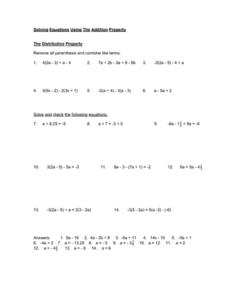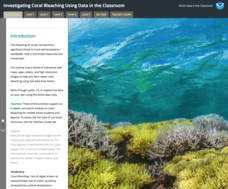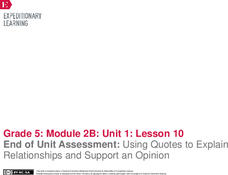Curated OER
Using Known Facts to Multiply and Divide Mentally
Building strong mental-math skills requires learners to have a strong number sense. They practice multiplying two and three-digit numbers in their heads using estimation or approximation. They estimate or round each number and then...
Curated OER
Using Partitioning to Double or Halve Numbers
Here is an engaging presentation that challenges your mathematicians to use the techniques of partitioning and halving in order to double or half numbers. After each technique is explained, learners are given a series of numbers to try...
Curated OER
Using Words: Verbal Communication
Written and verbal communication is the topic for today. The class goes over various facets of verbal communication, such as plain English, active voice, passive voice, cliché, and jargon. They then use those devices as they discuss...
Curated OER
Using a Cell Phone When Lost in the Community
We have all been lost at some point and for Special Needs individuals getting lost in the community can be a real issue. They prepare for a life of independence by memorizing their phone number and practicing what to do if they are lost....
Curated OER
MLA Documentation Tutorial: How to Cite Using MLA Style
Required to use the Modern Language Association (MLA) Style Guide for research writing? Here’s a presentation that models how to and when to cite a variety of sources, and how to create a Works Cited page. Color-coded examples highlight...
Curated OER
Reading Comprehension Strategy: Using Background Knowledge
The value of this presentation is that it not only defines background knowledge but includes exercises that show readers how to activate and use what they already know about a topic to make text-to-self, text-to-text, and text-to-world...
Lorain County Community College
Solving Equations Using the Addition Property
Challenge your mathematicians to simplify and solve a variety of different equations. This activity focuses on multi-step problems that begin with combining like terms and advance toward solving equations with variables on both sides. A...
NOAA
Investigating Sea Level Using Real Data
The news reports on rising sea level, but how do scientists measure this rise? Scholars use NOAA data including maps, apps, and images to work through five levels of activities related to sea level. Each level in the series adds a new...
NOAA
Investigating Coral Bleaching Using Data in the Classroom
Approximately 93 percent of the individual reefs in the Great Barrier Reef suffer from coral bleaching. Scholars learn how scientists monitor coral bleaching around the world as part of a larger series. They use actual data to answer...
Literacy Design Collaborative
Using Textual Evidence to Analyze Literary Responses to Historical Events
Scholars analyze Animal Farm to learn how to add textual evidence into essays to support their ideas. They search for a deeper meaning to the story and how it relates to the text Totalitarianism and Revolutions in Russia. To finish,...
EngageNY
Preparation for Performance Task: Using Writing to Make Prompt Cards
Writing becomes dynamic in a presentation. Presenters transform a piece of writing they have already composed about the Little Rock Nine into a presentation. The focus is transferring ideas from their writing into short prompts on cards...
EngageNY
Determining Cascading Consequences Using The Omnivore’s Dilemma: Industrial Organic Food Chain
Organic versus conventional farming: which option is best? Pupils use Michael Pollan's The Omnivore's Dilemma to determine the cascading consequences of the industrial organic food chain. They work in research teams to create an...
EngageNY
Using Search Terms for Further Research: Industrial Organic Food Chain
Class members conduct independent research to continue examining the consequences of the industrial organic food chain from Michael Pollan's The Omnivore's Dilemma. Pupils learn about source credibility and effective search terms, then...
University of Waikato
Make and Use a Hydrophone
Using a home-built hydrophone, pupils investigate how things sound in water. Learners listen to sounds created in air and then compare that to the same sound picked up by the hydrophone. Individuals compare the loudness and the pitch of...
EngageNY
Mid-Unit Assessment: Using Evidence to Support Analysis: “Frederick Douglass”
Show what you know! Scholars complete a mid-unit assessment using text evidence from Frederick Douglass. The teacher then presents expectations for independent reading assignment. Leaving the class, pupils turn in an exit ticket...
EngageNY
Using Multimedia in Presentations: Preparing to Present Claims
Time to wrap it all up! Using facts, details, and examples, pupils present their claims about whether the American Academy of Pediatrics should increase its screen time recommendations. They incorporate a multimedia visual display and...
EngageNY
Using Effective Search Terms: Researching Screen Time
The proof is in the reading. Scholars read an article, "Attached to Technology and Paying the Price," and answer text-dependent questions. Next, they complete a Venn diagram to contrast two authors' use of evidence on the topic of screen...
Teach Engineering
Powering a Device Using Food
Eat up a resource on using food to power electrical devices. Future engineers first experiment with different fruits and vegetables to determine the amount of electrical energy they provide. Based on the data, they design and create an...
Texas Education Agency (TEA)
Careers in BMAC using MAPP
Let's get down to business. Using the professional resource, pupils identify and explore careers in the field of business management. After taking an online career assessment, they research information about a chosen career.
EngageNY
End of Unit Assessment: Using Quotes to Explain Relationships and Support an Opinion
Think big! Scholars complete an end of unit assessment using their notes and graphic organizers along with the texts Big Thinkers: Was Steve Jobs This Generation’s Thomas Edison? and Steve
Jobs. To complete the assessment, they answer...
Flipped Math
Calculus AB/BC - Integrating Functions Using Long Division and Completing the Square
With just a little work, integrals can become much easier. The 11th of 16 installments in Unit 6 - Integration has viewers watch a video to learn different ways to rewrite an integrand before determining the integral. They use polynomial...
EngageNY
Whole Class Model Letter Writing: Organizing Reasons and Evidence and Using Transition Words
Where's the evidence? Scholars practice ordering the evidence and reasons for their class opinion papers by physically sorting them. Next, they work collaboratively to write a body paragraph, using linking words to connect their ideas...
Bonneville
What is Electricity and How Do We Use It?
Use some electrifying lessons to learn about electricity. Future scientists discover the history of electricity and the basics of electric circuits. They learn how to read an electricity bill and then create circuits to power a fan,...
EngageNY
Solving for Unknown Angles Using Equations II
The third activity in the series of 29 asks learners to identify types of angles to verify angle relationships. They find unknown measures using vertical, adjacent, complementary, supplementary, and 360-degree angles.
Other popular searches
- Addition Using Manipulatives
- Creating Art Using Music
- Chemical Change Using Apples
- Lessons Using Apples
- Multiplying Using Arrays
- Math Using Arctic Animals
- Addition Using Grouping
- Addition Using Unifix Cubes
- Adding Decimals Using Money
- Cultural Studies Using Math
- Add Fractions Using Pictures
- Addition Using Manipulative's























